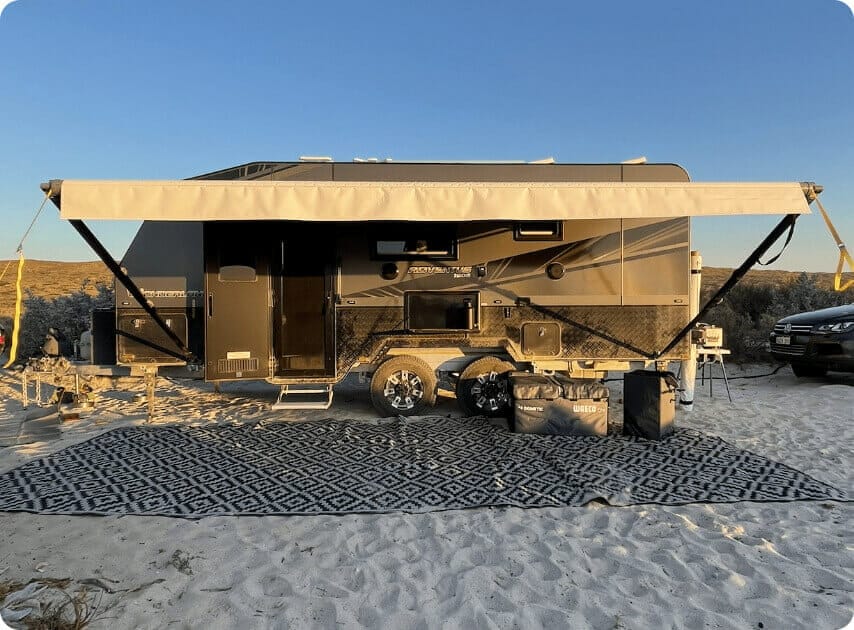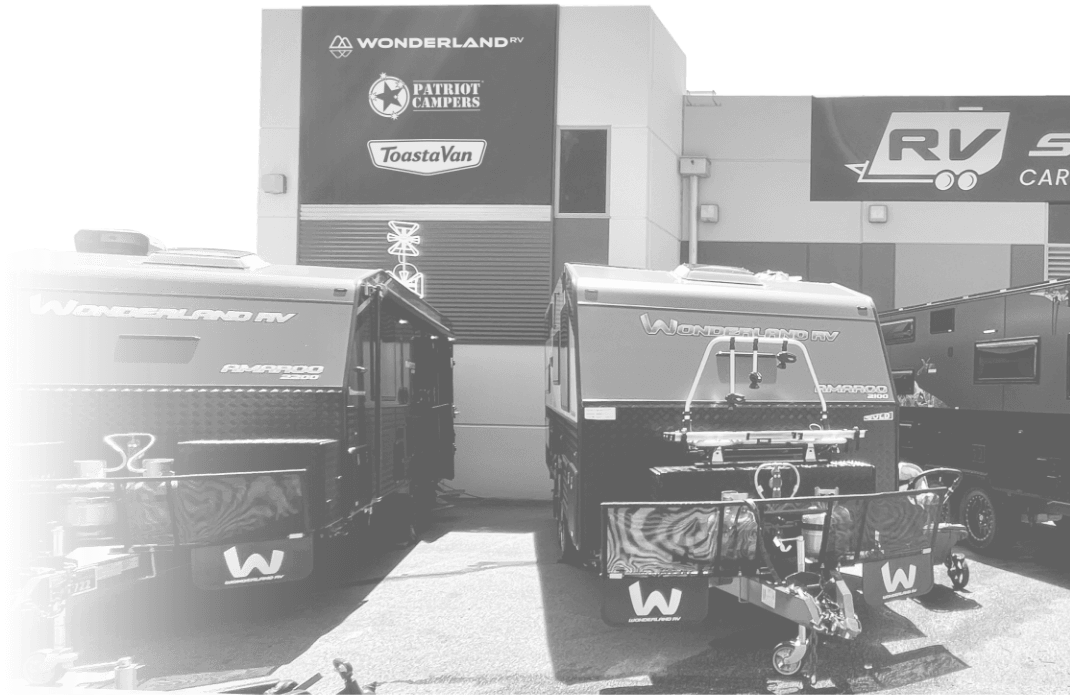
When looking for the perfect battery for your caravan, RV, camper trailer set up or even just for the 4bie, you’ll quickly realise not all batteries are equal. While they might all ‘do’ the same thing, technically, what they’re made of is a pretty important thing to consider.
At a glance, the three core types of batteries you’ll encounter are good old lead acid, AGM (Absorbent Glass Mat) and lithium (specifically, Lithium Iron Phosphate). Each of these batteries contain different internals, which give them their specific properties, and certain advantages over each other.
If you’re looking for a short, no fluff answer to which battery is going to be objectively ‘best’ for your caravan setup, the answer is lithium—they put out the most power, last the longest and weigh the least. But they’re the most expensive and need extra thought to make it all work properly (more on that later).
What’s going to work best for you is a harder question to answer, and is going to depend on what you’re trying to do, what you’re working with and how much you’re looking to spend. Rather than try and answer ‘which caravan battery should I buy’, we’re instead going to focus on the topic of lithium batteries vs lead acid vs AGM batteries.
First we’ll quickly touch on deep cycle batteries, then let’s dive into an overview of each battery type.
What’s a ‘deep cycle’ battery?
Without getting into technical specifics, batteries don’t actually put out as much power as it says on the tin. Your regular car battery, for example, is only really designed to output a small % of its total capacity. So if it were 100aH, you shouldn’t really deplete it past 80%, which means you’ve only really got 20aH of usable power stored. Not a lot. This is why car batteries generally aren’t marked for their amp hours, but their ‘cold cranking amps’—how much kick they can give a motor.
A deep cycle battery is designed to overcome some of these limitations, and give you more usable power. This is often achieved with thicker lead plates, among other internal tweaks. A deep cycle lead acid battery is often able to be discharged to 50%—meaning you’ll get 50 usable amp hours from a 100aH battery. Still not the most efficient battery in the world, but much better than using a car cranking battery to run your off-grid power system. The lifespan is also improved, meaning you’ll be able to charge, use then charge again, more times before the battery’s dead.
Lead Acid Batteries
A lead acid battery is exactly what it sounds like—lead and acid in a box, and that stores electricity. Inside said plastic box are lead plates, and between them is battery acid filled with electrolytes. That’s not all there is to lead acid though, did you know AGM batteries are still technically lead acid? It’s the material makeup of the lead plate + electrolyte combo that determines a lead acid battery’s categorisation and what it’s built for.
Flooded Lead Acid Batteries
The first, most basic type of lead acid battery. Often referred to as ‘unsealed’, ‘wet cell’ or ‘flooded’, these batteries contain a liquid acid and electrolyte mix floating around and between lead plates. They’re generally the cheapest type of battery you can buy, but they don’t last very long, require topping up with distilled water and release gases (no good for enclosed spaces). Most often found in cars as the starter battery, they’re generally not suitable for a caravan battery system due to the rather long list of downsides.
It’s for this reason that we don’t recommend them, and certainly don’t stock, sell or install them. There are simply much better options, and they’re really not suitable for caravans.
Absorbent Glass Mat
The same concept as flooded batteries, an AGM battery still uses a combination of electrolyte-rich battery acid and lead plates to form cells, and store electricity. But where the battery acid is free to slosh around and spill in the regular battery (hence, ‘flooded battery’), an AGM uses absorbent glass mat (basically, fibreglass matting) between the lead plates, which absorbs the battery acid. This prevents it sloshing around, and means the battery itself is maintenance free, sealed, doesn’t spill, is immune to vibration and doesn’t emit gases.
Bonus tip:
If you do have to choose a lead acid battery system for your caravan, be it due to cost, availability or to utilise the existing supporting systems, choose AGM batteries. They’re the most advanced, and the best of the lead acid options.
Gel Lead Acid
Basically halfway between a flooded lead acid battery and an AGM battery, the gel acid in this battery type reduces the sloshing and much of the downsides to a flooded battery. They’re not quite as good as an AGM battery though, and were an advancement in battery tech prior to AGM becoming the gold standard of lead acid. Now, they’re largely redundant as they don’t offer any advantages over an AGM battery and often aren’t any cheaper.
Similar to flooded lead acid batteries, we neither recommend or install gel lead acid batteries. The alternatives are simply better, longer lasting and often more affordable outright.
Lithium Batteries
Most of us have heard of lithium batteries, specifically Lithium Iron Phosphate batteries, as the future-tech that totally smashes archaic lead acid. Are they really that good? That much of an improvement? Well in a nutshell, yes, they are. Considering factors like weight, total usable output, lifespan, charge time and efficiency they completely dominate lead acid batteries.
LiFePO4 batteries are much lighter, offer much more usable power, charge faster and can be drained far more times before they’re dead. However, they’re not completely without compromise.
Lithium batteries are significantly more expensive in terms of upfront cost than similarly rated lead acid systems. This is largely accounted for by the battery management system that regulates the cells and ensures the battery is not charged too rapidly, overcharged or drained improperly. Lithium batteries are ‘smart’, and often have features such as bluetooth connectivity so you can monitor their status and capacity from your smartphone.
Do Lithium Batteries catch fire?
It’s a valid concern! We all saw the news headlines across the world a few years ago about Samsungs catching fire on planes, in pockets, on the bedside table… Good news, that’s a different type of lithium battery. Lithium-Ion batteries (Li-ion) catch fire, but the ones we sell and recommend for caravans are lithium iron phosphate (LiFePO4). These ones don’t catch fire!
Are Lithium Batteries worth the extra money, over AGM?
In our opinion, yes. A really solid battery system is absolutely critical for anyone trying to go off grid, or really anyone that doesn’t intend to spend every single night connected to 240v. It’s more a question of do you need batteries, or not, rather than lithium vs AGM.
Lithium batteries last longer than lead acid.
Why? First of all, lifespan. We touched briefly already on AGM batteries should only really be drained to 50% of their max charge. However, this isn’t the only downside. The lifespan of a battery isn’t determined by simple chronological time, 4 years for example. Batteries last based on the number of charge cycles they undergo; how many times they’re charged, drained and then charged again.
Draining a deep cycle lead acid battery to 50% of its max charge can only really be done 300 or so times before the battery is dead. Kaput. Need to be replaced. The average LiFePO4 battery on the other hand, lasts around 2,000 charge cycles, and can comfortably be drained from 100% to 20%, then charged to full again each time. Meaning you’ll get close to 8 times the amount of usable power from them before they require replacement.
Lithium batteries are lighter than lead acid.
The second reason we suggest lithium for all serious caravanners, is weight. The average power system in a caravan, when using lead acid batteries, weighs around 70kg. That’s a lot of weight when your maximum payload is 500kg. Nearly 15% of your total capacity, just on batteries. Lithium weighs just a fraction of that, typically less than a quarter for the same aH, and less again for the equivalent usable power.
What about the support systems?
A typical lead acid battery system is pretty basic. Most car chargers, be it direct connection from your car’s alternator to your caravan battery or just 12v straight out of the cigarette socket, are compatible with lead acid systems. This is partly due to how lead acid works, continuing to pump them with full power once they’re almost at capacity is how they’re designed to be charged.
LiFePO4 batteries, however, are much more efficient. They don’t need this final stage of slow charging to get them to capacity. Think about your phone, for example, it charges super fast compared to a flat car battery. But this efficiency is also a trap for new players. Lithium batteries don’t play nice with max power getting shoved at them when they’re already full. This is partly what their built in battery management systems are designed to account for, and why they’re expensive.
However, it’s still a good idea to ensure your solar charger, DC to DC charger, and any other methods you’re using to keep those lithium batteries topped up are designed for these systems. Which is why, if we do say so ourselves, we’d suggest having your lithium battery system fitted by professionals with a reputation for installing brilliant battery systems for caravans.
We’re specialists in all things off-grid, off-road and remote caravanning. Which means we’re super confident in delivering the perfect system for exactly what you need and what you want from your caravan and can install many different caravan accessories. Drop by today, or give us a call to discuss the options and work out your ideal system.
Check out our socials to find out more on recent builds and to keep up to date with us.



